Ca' Rezzonico
.jpg) The White marble façade of Ca' Rezzonico on the Grand Canal | |
| Established | 25 April 1936 |
|---|---|
| Location |
Dorsoduro 3136, 30123 Venice, Italy |
| Type | Art museum, Historic site |
| Director | Alberto Craievich |
| Website | carezzonico.visitmuve.it |
Ca' Rezzonico (Italian pronunciation: [ˈka (r)retˈtsɔːniko])[1] is a palazzo on the Grand Canal in the Dorsoduro sestiere of Venice, Italy. It is a particularly notable example of the 18th century Venetian baroque and rococo architecture and interior decoration, and displays paintings by the leading Venetian painters of the period, including Francesco Guardi and Giambattista Tiepolo. It it is a public museum dedicated to 18th-century Venice (Museo del Settecento Veneziano) and one of the 11 venues managed by the Fondazione Musei Civici di Venezia.
History
Construction (17th-18th centuries)
Ca' Rezzonico stands on the right bank of the canal, at the point where it is joined by the Rio di San Barnaba. The site was previously occupied by two houses, visible in early paintings of Venice in 1500, which a century and a half later were in a sad state of decay. They belonged to the Bon family, one of Venice's patrician clans, In 1649 the head of the family, Filippo Bon, a Procurator of the city and patron of the arts, decided to transform the two houses into a single large palazzo on the site. For this purpose he employed Baldassarre Longhena (1597-1682), the greatest proponent of Venetian Baroque, a style slowly replacing the Renaissance and Palladian architectural style. Longhena was the designer of the famous dome of the Church of Santa Maria della Salute, a Venice baroque landmark. By 1661 Longhena had combined the two earlier structures, and work had begun on the facade facing the canal, and had reached as high as the first, or Noble, floor. However, neither architect nor client was to see the completion of the Palazzo Bon: Longhena died in 1682, and Filippo Bon saw his finances ruined by the cost of the palazzo. He was forced to halt the work. [2]
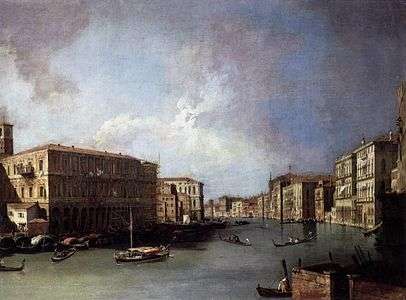 View of the Grand Canal by Canaletto in 1726. The unfinished Palazzo is the white building the center on the left.
View of the Grand Canal by Canaletto in 1726. The unfinished Palazzo is the white building the center on the left._-_n._021_-_Venezia_-_Palazzo_Rezzonico1.jpg) The Palazzo in the mid-19th century, by Carlo Naya
The Palazzo in the mid-19th century, by Carlo Naya.jpg) Detail of the facade
Detail of the facade
Filippo Bon died in 1712, and the unfinished palace, already decaying, was inherited by his sons and then grandsons, but none had the funds to complete the construction. In 1750 The Bons offered the unfinished palazzo to Giambattista Rezzonico. a banker and fabric merchant from Lombardy, whose family had bought a title of Venetian nobility in 1648, following a war with Turkey, when the Venetian state coffers were depleted. Rezzonico paid 60,000 ducats for the unfinished building. Municipal inspectors examined the building, and concluded that most of the structure was a ruin, in danger of collapse. Only the rear part of the building, completed up to the second floor, had a roof and could be saved. Rezzonico hired the most prestigious architect of his time, Giorgio Massari (1687-1766), who had built the churches of the Jesuits and the church of the Pieta in Venice, as well as the palazzo of the Grassi family, which faced the Rezzonico palace on the other side of the Grand Canal.[3]
A Canaletto painting of the early 18th century[4] shows only the ground floor and first piano nobile completed, and a temporary roof protecting the structure from the elements. The Rezzonics rushed the reconstruction along. In 1752, the accidental dropping of a piece of marble caused the scaffolding to collapse, dropping five stone masons to the ground below. [3] Massari largely followed the original plan of Lorghena, but made a number of modifications to suit the lighter rococo tastes. He removed some ponderous double columns on the facade replacing them with more slender pillars, and eliminated a heavy plinth of columns, giving the building a lighter, more graceful appearance. He also installed a row of small oval windows above the larger windows on the second floor, adding light and a rococo touch. [3]
The facade was finished between 1750 and 1752. Turning his attention to the interior, Massari broke with Venetian custom and put the major ceremonial room at the back of the building, not overlooking the canal. He doubled the height of the ceiling in this room and eliminated walls to create a more dramatic space. He laid out a ceremonial route that would take visitors from the dock and gateway on the Grand Canal to a fountain in the interior courtyard, surmounted by the coat of arms of the Rezzonico in marble; then taking a triumphal hallway to the monumental stairway which took them up to the grand salon or ballroom. As soon as the salons were completed, their ceilings were painted with frescoes by Giovanni Battista Crosato and in trompe-l'oeil by Girolamo Mengozzi Colonna. [5]
The interior work was nearly finished in 1756, The pinnacle of the Rezzonico's power and the Palazzo's grandeur came in 1758, when Carlo, the younger brother of Giambattista Rezzonico, was elected Pope as Clement XIII, the same year Ludovico Rezzonico married Faustina Savorgnan, uniting the two richest families in Venice. To mark that occasion, Rezzoncio commissioned the most celebrated painters of Venice; the aging Giovanni Battista Tiepolo, to paint the ceilings of two salons, along painters with Gaspare Diziani and Jacopo Guarana. [6]
The palace was the site of further celebrations in 1759, when Aurelio Rzzonico was elected Procurator of San Marco, and in 1762, when Ludovico Rezzonico was elected to the same position. For three nights, the facades and interiors of the palace were lit with torches and candle in celebration. Upon his election as Pope, Carlo Rezzonico transferred a large part of the family art collection from Venice to Rome. [6]
19th-20th century- decline and revival
Fifty years after the completion of the Palace, in 1810, the last member of the Venetian branch of the Rezzonicos. cardinal Abbondio of Pisa, died, bringing an end to the family line. The palace nearly became a Jesuit College, but went instead through several families, and in 1832 to Carlo Pindemonte, the grandson of a Piedomontese poet and political figure, Ippolito Pindemonte. Pindemonte sold the all the furnishings and art collections of the palazzo. Only the frescos remained in situ. In 1837, Pindemonte sold the empty building to Count Ladislao Zelinsky, he in turn rented the palazzo to the Baron von Bulow, then to count Zichj Cerner. From 1840 and 1857, it was rented to the Duke of Modena and his family, which included Don Carlo, the Duke of Madrid, the pretender to the Spanish throne. [6]
Beginning in about 1850, the second floor of the palae was rented by the antiquarian and art dealer Jacobo Querci della Rovere, who used it as a gallery to sell paintings by Rubens, Rembrandt, Caravaggio, Canaletto, and other old masters. In the 1880s, it became the home of the painter Robert Barrett Browning, whose father Robert Browning, the poet, died in his apartment on the mezzanine floor in 1889. At this time, the American portrait painter John Singer Sargent also had a studio in the palazzo.
In 1906 Browning received an offer from the German Emperor, Wilhelm II, to buy the building, but sold it instead to Count Lionello von Hierschel de Minerbi, a deputy of the Italian parliament and a collector of modern art. The Palazzo became the setting for spectacular costume balls, celebrations by torchlight and candlelight, and concerts.
American songwriter and composer Cole Porter rented Ca' Rezzonico for $4,000 a month in the 1920s.[7] Porter engaged 50 gondoliers and employed a troupe of high-rope walkers to "perform in a blaze of colored lights".[8]
The global depression of the 1930s brought an end to Minerbi's funds and extravagance, and he sought a buyer for the Palace. After four years of negotiations, in June 1935 the city of Venice purchased the Palazzo and began to transform it into a museum of Venetian art from the 18th century.Works of art of the 18th century, including ceiling frescoes, from other houses and collections owned by the municipality were brought together in the Ca' Rezzonico, to accompany the original frescos on the ceilings. The city also purchased additional works by Tiepolo, Guardi, Canova and other artists to augment the collection. The building underwent a major restoration in the late 1970s and was completed in 2001.[9]
The ground floor and courtyard
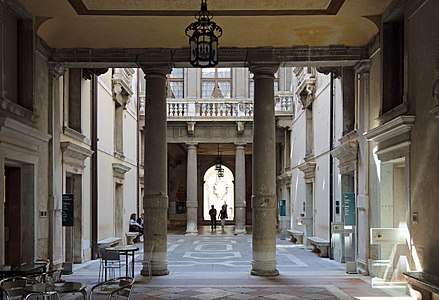 Ground floor passage from the Grand Canal to the inner courtyard and fountain
Ground floor passage from the Grand Canal to the inner courtyard and fountain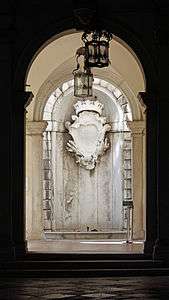 Fountain in courtyard with Rezzonico coat of arms
Fountain in courtyard with Rezzonico coat of arms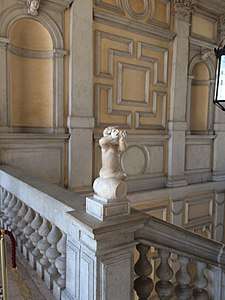 Grand stairway up to the Piano Nobile
Grand stairway up to the Piano Nobile
Visitors typically arrived by gondola at the main entrance, opening onto the Grand Canal. The building is narrow and deep, with the facade on the canal only three rooms wide. Visitors passed through the entrance, and down a long corridor to the courtyard, where a fountain is placed, with the coat of arms of the Rezzonico family. The entrance to the streets of Venice is behind the fountain. From the ground floor, visitors climb to the Piano Nobile by the staircase of honour, which has marble balustrades decorated with statuary by Giusto Le Court. Le Court was the leading sculptor in Venice in the late 17th century, and worked closely on many projects with the first architect of the building, Longhena.
Piano Nobile
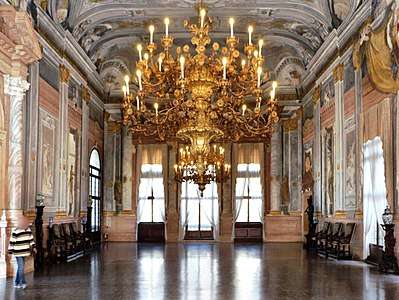 The ballroom, the largest room in the Ca' Rezzonico
The ballroom, the largest room in the Ca' Rezzonico%2C_1753%2C_02.jpg) The Chariot of Apollo fresco on the ceiling of the ballroom, by Giovanni Battista Crosato (1753)
The Chariot of Apollo fresco on the ceiling of the ballroom, by Giovanni Battista Crosato (1753)%2C_1753%2C_01.jpg) Trompe L'Oeil decoration of the ballroom ceiling by Girolamo Mengozzi Colonna
Trompe L'Oeil decoration of the ballroom ceiling by Girolamo Mengozzi Colonna
The Palazzo's ceremonial rooms are located on the piano mobile. The largest and most impressive is the grand salon or ballroom, fourteen by twenty-four meters in size, at the rear of the building, This room, created by Massari, is of double height, and appears even higher because of the trompe l'oeil architecture painted on the walls and ceiling by Girolamo Mengozzi Colonna (not by Pietro Visconti, as long believed).[10] The centerpiece of the ceiling, painted by Giovanni Battista Crosato, depicts Apollo riding his carriage between Europe, Asia, Africa and The Americas. The coat of arms of the Rezzonico family, with a double-headed eagle, also is prominently displayed on the wall of the ballroom facing the entry door. The two enormous chandeliers made of wood and gilded metal, from the mid-18th century, are among the few fixtures that date to the original period of the building. The ballroom is now decorated with 18th century statues by Andrea Brustolon, including a statue of an Ethiopian warrior carved of ebony.[10]
 Wedding couple in chariot on the ceiling of the Salon of the Allegory, by Giambattista Tiepolo (1758)
Wedding couple in chariot on the ceiling of the Salon of the Allegory, by Giambattista Tiepolo (1758) Detail of the ceiling of the Salon of the Allegory, by Giambattista Tiepolo and Girolamo Mengozzi Colonna (1758)
Detail of the ceiling of the Salon of the Allegory, by Giambattista Tiepolo and Girolamo Mengozzi Colonna (1758)
The Salon of the Allegory, a room decorated to commemorate the 1758 marriage of Ludovico Rezzonico, the nephew of Pope Clement XIII Rezzonico, and future procurator of San Marco, to Faustina Savorgnan, is also on the Piano Nobile. The ceiling has a large fresco by Giambattista Tiepolo and his son, Giandomenico Tiepolo, depicting the groom and his bride ferried by Apollo's chariot.[11] It was one of th last works of Tiepelo in Venice, before his departure for Madrid in 1762. Tiepelo completed the work on the ceiling in only twelve days on the scaffolding. The Tiepolo fresco, like the paintings in the Grand salon, are framed by trompe l'oeil paintings of architecture, including a false balustrade, by Girolamo Mengozzi Colonna, who also did the painted frames in the Grand Salon. The painting depicts the bridal couple in a chariot, being led by the sun gold, Apollo. Other allegorical figures include cupid blindfold, a flight of putti and doves, the figure of Fame, holding a trumpet; the three graces on a cloud; a bearded old man with a laurel crown symbolizing Merit; and a lion, the symbol of Venice, along with coats of arms of the two families. [10]
The furnishings of the salon included paintings and furnishings by Italian artists of the first half and mid-18th century, including portrait of Pope Clement XIII Rezzonico by Anton Raphael Mengs, a retable by Francesco Zugno, a pupil of Tiepolo, and a prie-dieu of carved walnut illustrating the fantasy of the Italian rococo style.
A passage from the Salon leads to a small chapel, suspended over the Rio San Barnaba. The chapel was built by either Aurelio Rezzonico or Cardinal Rezzonico, the nephew of Pope Clement XIII, in the second half of the 18th century. Some of the original decoration remains, including the sculpted and gilded rococo stucco sculpture on the white walls, and a retable, The Virgin and Saints, by a pupil of Tiepolo, Francesco Zugno., and prie-dieu, or seat for kneeling and praying, in the twisting and turning Veneitian rococo style. [12]
The Salon of Pastels was originally a room for holding audiences; in that room the Papal Legate informed Cardinal Rezzonico that he had been elected Pope the day before. The ceiling is decorated with frescos depicting the Triumph of the Arts over Ignorance, presented in a tromp-l'oeil painted frame, with allegorical scenes painted in the corners. The paintings , particularly The Triumph of Poetry, date from the time when Tiepolo was working in the main salon, and are usually attributed to either Giambattista Crosato or Gaspare Diziani of Beluno. The room takes its name from the number of pastel portraits by Rosalba Carriera and other notable Venetian artists. They include a fine pastel portrait of the opera singer Faustina Bordoni by Carriera. Another notable pastel portrait is that of Cecilia Guardi Tiepolo, wife of the painter Tiepolo, painted by her son Lorenzo. It was painted in 1757. [13]
The Tapestry Hall features three large Flemish tapestries from the end of the 17th century, as well as sculpted and gilded furniture from the period. The ceiling frescoes represent The Triumph of Virtue, by Jacopo Guarana. The yellow door is also notable; it portrays a lacquered painting of a Chinese woman with a parasol, surrounded by floral motifs, and dates from 1760.[14]
The Throne Room, at the end of the piano nobilie, looks out at both the Grand Canal and the Rio San Barnaba. it takes its name from an elaborate gilded and sculpted wooden throne which was used during the brief visit of Pope Pius VI in 1778, on his way from Rome to Vienna. It was also the bridal chamber of Ludovico Rezzonico and Faustina Savorgnan. Besides the throne, its other notable features of the room are the ceiling frescos, titled The Allegory of Merit, which were painted by Tiepelo and his sons in just twelve days. The furniture in the room is also notable, particularly sculpted and gilded tables, mirrors and candlesticks, ornamented with statues of putti and figures representing the different virtues. The room also features several fine Chinese porcelain vases. [15]
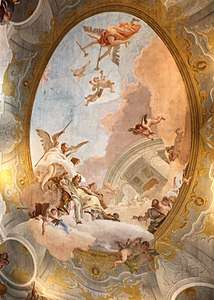 Allegory of Merit by Giambattista Tiepolo (1757)
Allegory of Merit by Giambattista Tiepolo (1757)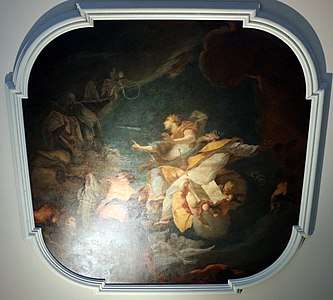 Allegory of Merit by Mattia Bortoloni (1720–30), in the Morlaiter Hall
Allegory of Merit by Mattia Bortoloni (1720–30), in the Morlaiter Hall Lucrezia by Filippo Parodi
Lucrezia by Filippo Parodi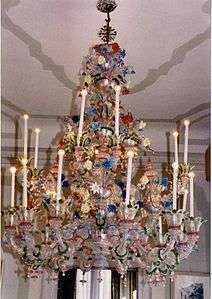 Murano glass chandelier in the Brustolon Hall by Giuseppe Briani (mid-18th century)
Murano glass chandelier in the Brustolon Hall by Giuseppe Briani (mid-18th century)
The Tiepolo Hall has the third of the four Tiepolo ceilings in the building, called Nobility and Virtue defeating Ignorance. Unlike the other Tiepolo ceilings, this ceiling, painted in 1744-45, was not made for the Ca' Rezzonico, but for the family of Pietro Barbarigo for his own house in Santa Maria del Giglio. It was bought by the city of Venice in 1934 and installed in the museum. The room also displays paintings by Venetian artists, including Pietro Longhi, Francesco Guardi, and two early works in oval frames by Giambattista Tiepolo from 1715-16. The furnishings also pieces of Venetian baroque furniture, including a gaming table, and an ornate painted secretary, or cabinet, used to hold previous objects, made in Germany in the 18th century.[16]
The Morlaiter hall is furnished like a library, with four large bookcases filled with small sculptures in terra-cotta or baked earth by the Ventian sculptor Giovanni Maria Morlaiter (1699-1781), which were acquired for the museum by the City of Venice in 1935. The ceiling has a fresco on the same theme as the Tiepolo fresco in the Throne Room, Allegory of Merit, by Mattia Bortoloni.
The Lazzarini Hall takes its name from the Venetian painter Gregorio Lazzarini, from the end of the 17th century. The three large mythological paintings in the room were attributed to him in the 19th century. More recent scholarship attributes one painting in the room, Orpheus massacred by the Bacchanantes, to Lazzari. The others are now attributed to Antonio Bellucci and Antonio Molinari. The five oval paintings on the ceiling, also on mythological themes, are by Francesco Maffei, from the end of the 17th century. The room also features a very fine marquetry desk, inlaid with ivory and decorated with gilded bronze, by the ebenist Pietro Pifetti, signed and dated 1741. [17]
The Brustolon Hall is devoted to the sculpted furniture and carved figures of Andrea Brustolon, he most celebrated Venetian baroque wood sculptor. The works displayed are dated 1706, and use different colored woods, including ebony, and extremely ornate baroque curves and twists to portray action and emotion. The room also features a notable chandelier with multi-colored glass in floral forms from the Murano glass workshop of Giuseppe Briani, made in the middle of the 18th century. [18]
Second floor galleries
The second (third, in U.S. use), or upper floor, contains a series of galleries displaying Venetian paintings and decorative arts from the 18th century. Several major paintings by Canaletto are on display, including Architectural Caprice and two views of the Grand Canal, painted in 1719-20 during his youth. They marked the beginning of his famous series of Venice scenes. They were purchased for the museum by the City of Venice in 1983. Another large-scale depiction of the port The festival of Saint Martha by Gaspare Diziani, is also on display, along with several celebrated scenes of life in Venice during the period by Francesco Guardi. Several frescos by Guardi, including The Triumph of Diana, are on display in the Guardi Hall.
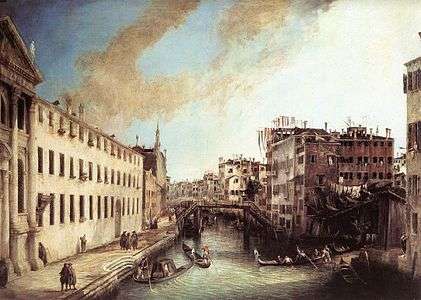 The Rio dei Mendicanti by Canaletto
The Rio dei Mendicanti by Canaletto_-_Museo_del_Settecento_Veneziano_-_Ca'_Rezzonico%2C_Venice.jpg) The Veiled Woman (Puritas) by Antonio Corradini
The Veiled Woman (Puritas) by Antonio Corradini_-_WGA10831.jpg) Il Rodotto (detail) by Francesco Guardi
Il Rodotto (detail) by Francesco Guardi
Other major works that can be seen on the top floor include the historical The Death of Darius by Giovanni Battista Piazzetta; and a collection of three portraits by Pietro Bellotti. Also represented in the museum collection, with a pastel, is the Venetian artist Maria Molin.[19]
Other Venetian artists whose works can be seen on this floor include Cima da Conegliano, Alvise Vivarini, Bonifacio de' Pitati; Tintoretto, Schiavone, the Bassano family, Paolo Fiammingo, Lambert Sustris; Padovanino and Carpinoni, Pietro Vecchia, Giovanni Segala, Palma il Giovane, Bernardo Strozzi, Francesco Maffei, Giovan Battista Langetti, Pietro Liberi; Balestra, Niccolò Bambini, Piazzetta, Nicola Grassi, [ Pietro Longhi, Rosalba Carriera, Sebastiano and Marco Ricci, Pellegrini, Amigoni, Antonio Marini, Zuccarelli, Zais, Giuseppe Bernardino Bison, Natale Schiavoni, Ippolito Caffi, Mancini, and Emma Ciardi.[20]
The second floor rooms also display notable works of sculpture, including The veiled woman by Antonio Corradini, where the marble gives the illusion of fabric. Besides paintings, the galleries on the top floor have examples of Venetian furnishings, including lacquered cabinets and chests decorated with polychrome flowers; porcelain, glassware, and musical instruments, including an 18th century clavecin, or early ancestor of the piano. An alcove bed from the period is also on display, originally from the Carminati Palace at San Stae in Venice. It includes its original carved wood trim around the bed, with decorative fabrics and paintings, including a portrait of the Virgin Mary by Rosalba Carriera, in blue and silver tones, presented in its original frame. from the late 18th century.[21]
The Pulcinella Frescos from Villa Zianigo
A section on the second floor contains rooms with of frescos by Giandomenico Tiepolo, son of Giambattista Tiepolo, which were originally in the Villa Zianigo, near Murano. Pulcinella was a standard character in Italian Commedia dell'arte since he 17th century, a figure for ridicule and satire; he wore a tall white hat and gown, a mask, and carried a club or long forks. The frescos They were begun in about 1759, and illustrate the stories of Pulcinella in various comic or satiric scenes. They were originally made by the elder Tiepolo for his own country house. They were finished in about 1797. File:Giandomenico Tiepolo Minuetto in villa Affreschi da villa di Zianigo Ca’ Rezzonico Dettaglio.jpg Another important Tiepolo work is displayed in tho section; the New World; a long fresco in the corridor which was originally on the ground floor of the Villa Zianigo, depicting a line of Venetians, including one in a Pulcinella costume with a long a fork, waiting to look into a magic lantern presentation, Promenade is said to show Tieolo himself, to the right, looking at the scene ironically through his eyeglass. On the opposite wall are two more scenes, Promenade and Minuet, showing, also in a certain ironic vein, Venetian aristocrats dancing and promenading. [22]
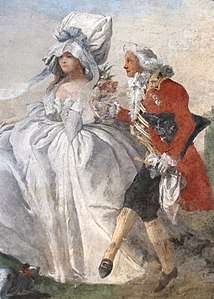 A Minuet by Giandomenico Tiepolo, from Villa Zianigo
A Minuet by Giandomenico Tiepolo, from Villa Zianigo
The Pulcinella Room, in this section, contains a group of three frescoes by Giandomenico Tiepolo from the Villa, called Pulcinella in Love, Pulcinella and the Saltimboques, and the Departure of Pulcinella. The round fresco on the ceiling depicts Pulcinella seen from below walking across a tightrope. These paintings were made between 1793 and 1797 at the Villa Zianigo. at the time of the first occupation of Venice by the French, and the beginning of downfall of the Venetian Republic, and its particular style of life and art.
The Pulicinella section contains two more rooms, the Cabinet of the Centaurs and the Cabinet of Satyrs, with monochromatic scenes by Giandomenico Tiepolo of themes and creatures. The ceiling of the Cabinet of Centaurs has a red monochrome meed image called Rhapsody, which is said to be a tribute to the poet Homer, along with medallions and images of mythological scenes and creatures, On the ceiling is a large rectangular painting of Scenes from Roman History, and, over the doors, more images of both male and female satyrs. [23]
'The Chapel is a room which displays paintings by Giandomenico Tiepolo for the chapel of the Villa Zianigo, which was consecrated in 1758. The paintings are signed by Giandomenico Tiepolo with the date 1759. The main figure in the paintings is Saint Jerome Émilien, depicted with handcuffs to represent his imprisonment in 1511 by soldiers of the Holy Roman Empire, and his liberation, according to the, legend, through the intervention of the Virgin Mary.[24]
The Third Floor and the Mezzanine- Martini Collection and Mestrovich Collection
The third and top floor (second floor in U.S. usage) has a recreation of an 18th century Venetian pharmacy, which was reconstituted in 1936 with original materials from a pharmacy of the period. It also includes an art gallery devoted to the collection of 264 paintings of collector Egidio Martini, including works from the 15th to the end of the 19th century by the major Venitian masters. It occupies nearly the entire third floor. It includes important works by Bernardo Strozzi, Francesco Maffei, Pietro Vecchia, the Tiepolos father and son, Giambattista Piazzetta, Gaspare Diziani, and other major Ventian masters.
The mezzanine, reached by the stairway to the ground floor, contains another gallery displaying the Mestrovich Collection, by Ferrucio Mestrovich, whose family lived in Dalmatia, and who emigrated to Venice in 1945. He donated his collection to the Museum in December 2001 and October 2009. It consists of about thirty paintings from the 15th to 20th century, It includes major works by Jacopo Tintoretto and Bonifazio Veronese, among others. [25]
References
- ↑ "ca'" and "Rezzonico" in Dizionario d'ortografia e di pronunzia
- ↑ Pedrocco 2012, pp. 9-10.
- 1 2 3 Pedrocco 2012, pp. 10-11.
- ↑ Canaletto painting
- ↑ Pedrocco 2012, pp. 13.
- 1 2 3 Pedrocco 2012, pp. 14-15.
- ↑ "Cole Porter Is Dead; Songwriter Was 72". The New York Times. 1964-10-16. Retrieved 2012-11-26.
- ↑ Nielsen Business Media, Inc. (29 October 1949). Billboard. Nielsen Business Media, Inc. pp. 45–. ISSN 0006-2510. Retrieved 26 November 2012.
- ↑ Pedrocco 2012, pp. 16-21.
- 1 2 3 Pedrocco 2012, p. 21.
- ↑ Tiepolo fresco.
- ↑ Pedrocco 2012, p. 33.
- ↑ Pedrocco 2012, p. 43.
- ↑ Pedrocco 2012, p. 45.
- ↑ Pedrocco 2012, p. 48-57.
- ↑ Pedrocco 2012, pp. 58-63.
- ↑ Pedrocco 2012, pp. 72.
- ↑ Pedrocco 2012, pp. 75=88.
- ↑ Alberto Cottino (2003). La donna nella pittura italiana del Seicento e Settecento: il genio e la grazia. U. Allemandi.
- ↑ Third floor.
- ↑ Pedrocco 2012, p. 139.
- ↑ Pedrocco 2012, p. 139-148.
- ↑ Pedrocco 2012, p. 154-55.
- ↑ Pedrocco 2012, p. 156.
- ↑ Pedrocco 2012, pp. 159-65.
Bibliography
External links
| Wikimedia Commons has media related to Ca' Rezzonico (Venice). |
- (in English) Official Ca' Rezzonico museum website
- Giambattista Tiepolo, 1696-1770, a full text exhibition catalog from The Metropolitan Museum of Art, which includes material on Ca' Rezzonico
Coordinates: 45°26′00″N 12°19′34″E / 45.433470°N 12.326242°E